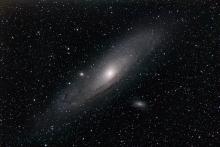Listen to today's episode of StarDate on the web the same day it airs in high-quality streaming audio without any extra ads or announcements. Choose a $8 one-month pass, or listen every day for a year for just $30.
You are here
Andromeda Galaxies
The hub of a galactic empire climbs the eastern sky on October evenings. M31, the Andromeda galaxy, is well up in the east-northeast at nightfall. Under dark skies, it looks like a smudge of light. But it’s actually a family of hundreds of billions of stars. It’s two and a half million light-years away — the farthest object that’s easily visible to the eye alone.
About three dozen other galaxies orbit M31. A couple of them are impressive on their own. But most of them are little more than puffballs. They contain no more than a few hundred million stars, so they’re small and faint.
In fact, some of them probably are ex-galaxies. The gravity of M31 has pulled them apart, so they’re just blobs of stars and gas that are spreading out.
About half of the satellite galaxies orbit M31 in a wide, thick disk, known as the Great Plane of Andromeda. And most of the members of the plane orbit M31 in the same direction, just as all the planets in the solar system orbit the Sun in the same direction.
That’s a bit of a surprise. According to models of how galaxies form, the smaller ones should be scattered around M31 at random — there shouldn’t be a pattern to them. But similar disks have been found around the Milky Way and another large galaxy.
There are several possible explanations for the orderly arrangement of the galaxies. But so far, none of them is convincing. So theorists have a lot of work to do to explain what’s going on.
Script by Damond Benningfield






